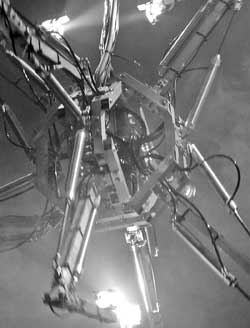Robography creates the illusion of life
Bill Vorn’s work explores anthropomorphism

The Prehysterical Machine is one of several robots Bill Vorn has built to explore human emotion through machine, light and sound.
Robotic artist Bill Vorn wants to know how a machine can be made to discover itself.
In a lecture titled “Artificial Life and Robotic Art: Creating the Illusion of Life,” Vorn, a professor in Concordia’s Intermedia/Cyber-arts program, spoke Nov. 30 at the Montreal Museum of Contemporary Art (MACM) as part of the Faculty of Fine Art’s lecture series, The Defiant Imagination.
As the founder of A-Lab, a robotic arts laboratory, Vorn explores the possibilities of endowing structures of metal with capabilities of personal awareness.
He is a working member of the Hexagram Institute, a media arts and technology group run jointly by researchers from Concordia and UQAM.
Vorn’s lecture was arranged around his “robography,” a chronological presentation of his various robotic projects spanning 1992 to the present. His explanations of the projects were accompanied by videos of the installations in action.
These included Espace Vectoriel (1993), an arrangement of eight sound and light cannons that reacted to the presence of spectators, swivelling on their bases, rising, falling and firing rhythms of bright, loud blasts.
La cour des miracles (1997) is what Vorn calls a “freak show” of dysfunctional, deranged robots. Among them are “the heretic machine” and “the limping machine,” metallic structures that depict suffering through movement and sound. These creations rely on the human tendency of anthropomorphism, or ascribing human meaning where it doesn’t exist.
But this projection of human emotion on unfeeling displays of metal, light and sound is variable, he said. When someone in the audience commented on the sinister and tortured aesthetic of his works, Vorn responded that not everyone sees it that way.
“There are children who laugh as if it was a scene from Disneyland; there are people who are really irritated by the work, and there are those who begin to cry,” he said.
The programming of Vorn’s robots makes use of computer software that he continues to develop as part of his research.
Many of his projects are made in collaboration with other artists, notably Louis-Philippe Demers. Together they created Le Procès (1999), a robotic per-formance created for Zulu Time, a play by Quebec stage and cinema director Robert Lepage.
The 15 works of Vorn’s robography have been exhibited throughout Europe, Asia, North and South America and have won numerous prizes and honours.
With each successive work he furthers the possibilities of artistic creation with artificial life.
“The conclusion is that there really isn’t a conclusion,” he said in closing his lecture. The field is wide open for exploration.
Rotoscopic Machines (2005), among Vorn’s latest projects, is currently at the Montreal Science Centre until March 2006 as part of the X-treme Rotation exhibition.